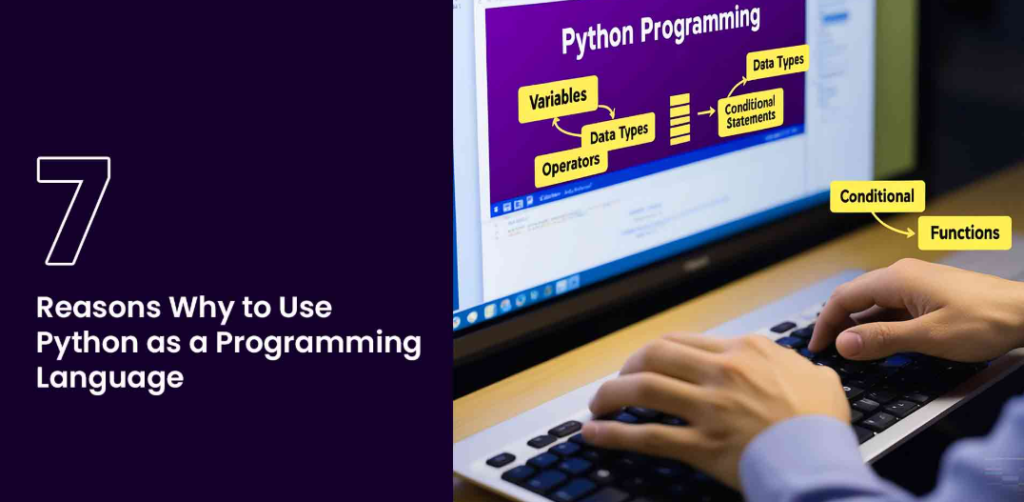PYTHON

Best Python Training In RT Nagar, Bengaluru, India
Python:
What is Python?
Python is a high-level, interpreted, general-purpose programming language known for its simplicity, readability, and versatility. It is widely used in web development, data science, machine learning, automation, and more.
✅ Key Features of Python:
✔ Easy to Learn – Simple syntax similar to English.
✔ Cross-Platform – Works on Windows, macOS, and Linux.
✔ Extensive Libraries – Pre-built modules for various applications.
✔ Object-Oriented & Functional – Supports multiple programming paradigms.
✔ Scalable & Efficient – Used by companies like Google, Netflix, and Instagram.
Why Use Python?
📌 Beginner-Friendly – Ideal for new programmers.
📌 Versatile – Used in multiple industries (AI, web dev, cybersecurity).
📌 Large Community – Active support and regular updates.
📌 Automation – Easily automates repetitive tasks.
📌 Data Science & AI – Powers advanced analytics and machine learning.
Python Installation & Setup
🔹 Download Python: Official Website
🔹 Install on Windows/macOS/Linux
🔹 Check Installation:
python --version
🔹 Use Python Interactive Mode:
python
🔹 Exit Python Shell:
exit()
Python Syntax & Basics
1️⃣ Variables & Data Types
name = "John" # String
age = 25 # Integer
price = 99.99 # Float
is_active = True # Boolean
2️⃣ User Input
name = input("Enter your name: ")
print("Hello, " + name)
3️⃣ Operators
a = 10
b = 5
sum = a + b # Addition
diff = a - b # Subtraction
prod = a * b # Multiplication
quot = a / b # Division
Control Structures
1️⃣ Conditional Statements (if-else)
age = 18
if age >= 18:
print("You are an adult")
else:
print("You are a minor")
2️⃣ Loops (for, while)
# For Loop
for i in range(5):
print("Iteration:", i)
# While Loop
x = 1
while x <= 5:
print(x)
x += 1
Functions & Modules
1️⃣ Defining Functions
def greet(name):
return "Hello, " + name
print(greet("Alice"))
2️⃣ Importing Modules
import math
print(math.sqrt(16)) # Output: 4.0
3️⃣ Custom Modules
# mymodule.py
def welcome():
return "Welcome to Python!"
# Import in another script
import mymodule
print(mymodule.welcome())
Python Data Structures
1️⃣ Lists (Dynamic Arrays)
fruits = ["apple", "banana", "cherry"]
fruits.append("orange") # Add item
print(fruits[1]) # Access item
2️⃣ Tuples (Immutable Lists)
colors = ("red", "green", "blue")
print(colors[0]) # Output: red
3️⃣ Dictionaries (Key-Value Pairs)
person = {"name": "John", "age": 30}
print(person["name"]) # Output: John
4️⃣ Sets (Unique Elements)
numbers = {1, 2, 3, 4, 5}
numbers.add(6)
print(numbers)
Object-Oriented Programming (OOP) in Python
1️⃣ Creating a Class & Object
class Person:
def __init__(self, name, age):
self.name = name
self.age = age
def greet(self):
return f"Hello, my name is {self.name}"
p = Person("Alice", 25)
print(p.greet())
Python File Handling
1️⃣ Reading a File
with open("example.txt", "r") as file:
content = file.read()
print(content)
2️⃣ Writing to a File
with open("example.txt", "w") as file:
file.write("Hello, Python!")
Python Libraries & Frameworks
📌 Web Development – Flask, Django
📌 Data Science & AI – NumPy, Pandas, Matplotlib, TensorFlow
📌 Automation – Selenium, BeautifulSoup
📌 Game Development – Pygame
📌 Cybersecurity – Scapy
Python for Data Science
🔹 1️⃣ Using Pandas for Data Analysis
import pandas as pd
df = pd.read_csv("data.csv")
print(df.head()) # Display first 5 rows
🔹 2️⃣ Using Matplotlib for Data Visualization
import matplotlib.pyplot as plt
x = [1, 2, 3, 4]
y = [10, 20, 25, 30]
plt.plot(x, y)
plt.show()
🔹 3️⃣ Using NumPy for Numerical Computation
import numpy as np
arr = np.array([1, 2, 3, 4, 5])
print(np.mean(arr)) # Calculate mean
Python for Machine Learning
🔹 1️⃣ Using Scikit-learn for ML Models
from sklearn.linear_model import LinearRegression
model = LinearRegression()
🔹 2️⃣ Using TensorFlow for Deep Learning
import tensorflow as tf
print(tf.__version__) # Check TensorFlow version
Python for Automation (Scripting & Web Scraping)
1️⃣ Automating Tasks with Python
import os
os.system("mkdir new_folder") # Creates a folder
2️⃣ Web Scraping with BeautifulSoup
import requests
from bs4 import BeautifulSoup
url = "https://example.com"
page = requests.get(url)
soup = BeautifulSoup(page.content, "html.parser")
print(soup.title.text)
Python Career Opportunities & Salary
📌 Job Roles:
✔ Python Developer
✔ Data Scientist
✔ Machine Learning Engineer
✔ Software Engineer
✔ Automation Engineer
Python Trends & Future
🚀 1. AI & Machine Learning – Python is leading AI innovations.
🚀 2. Automation & Robotics – Automating repetitive tasks.
🚀 3. Web & App Development – Flask & Django for scalable applications.
🚀 4. Cloud Computing – AWS, Azure, Google Cloud use Python.
🚀 5. Cybersecurity – Ethical hacking, security automation.
Conclusion
✅ Python is one of the most powerful and versatile programming languages today.
✅ It is used in various fields including web development, AI, data science, and automation.
✅ With its simple syntax and vast libraries, Python is ideal for beginners and professionals alike.
